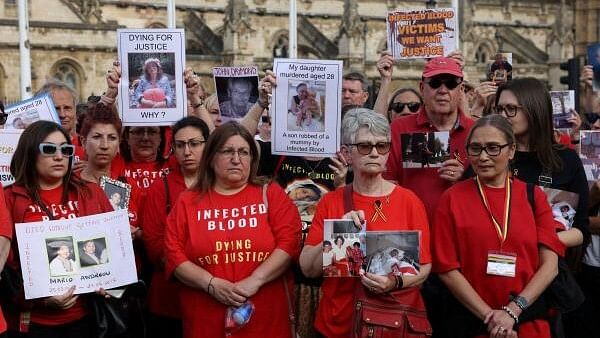
People impacted by the contaminated blood scandal gather in Westminster ahead of the release of the final report of the Infected Blood Inquiry.
Credit: Reuters Photo
An independent inquiry report released on Monday exposes the UK government's cover-ups regarding the contaminated blood scandal that took the lives of at least 3,000 people, Indian Express reported.
The report revealed that due to the negligence of the state-funded National Health Service (NHS), thousands were infected with HIV or Hepatitis. Worse, the government subsequently tried to cover up the errors that lead to this disaster.
Brain Langstaff, inquiry chair told Reuters, "successive governments hid the truth to save face and to save expense and the cover-up was more subtle, more pervasive and more chilling in its implications.”
Prime Minister Rishi Sunak apologised to the victims and their families. “I find it almost impossible to comprehend how it would have felt... I want to make a whole-hearted and unequivocal apology. On behalf of this and every government stretching back to the 1970s, I am truly sorry", he said.
The inquiry was launched during the tenure of Theresa May in 2017 to look into the cause of such diseases in the 1970s and 1980s. It was estimated that at least 3,000 people died owing to transfusion complications till 2019, IE reported.
Authorities have paid a compensation of 100,000 pounds to each survivor and the grieving families.
Let's take a look at how UK's national tragedy, stretching over decades, unfolded and what the 'contaminated blood' scandal is all about.
What is NHS?
NHS was established by the National Health Service Act in 1946, followed by a 1948 legislation setting down the guidelines for the national health services provider.
The UK populace is covered under NHS that provides health services to the public, free of cost, though there may be few minimum charges involved.
It is the world's fifth largest employer and the largest non-military public organisation that consists of four services in England, Scotland, Wales and Health and social care in Northern Ireland.
NHS administers medical services in three separate groups — general practitioner and dental services, hospital and specialist services, and local health authority services.
What exactly is the contaminated blood scandal?
Thousands of people in the UK who had haemophilia (blood clotting disorder) in 1970s and 1980s, were sold or donated blood by HIV positive and hepatitis-infected people. Contaminated blood was also given to people at the time of childbirth and surgery.
In 1970, NHS used a new treatment called Factor VIII for haemophilia. In this treatment, plasma was pooled from multiple donors to create a pharmaceutical product and it was considered 'wonder drug' for the patients, IE report noted.
The product used was imported from US, where a majority of donors were prisoners or intravenous drug users, who were paid for the donation.
More than 30,000 people were consequently infected with HIV, Hepatitis C, the report revealed. 1,250 haemophiliacs were infected with both. A Guardian report has revealed that about 380 children were infected with HIV.
Another report by The Independent revealed that 2,400-5,000 recipients developed hepatitis C and nearly two-thirds of HIV-infected patients died later due to AIDS-related illness.
Was this an accident?
BBC News accessed documents revealing that clinical trials of infected blood products was done on children as young as 2-years-old despite there families not consenting.
BBC reported that majority of children who enrolled in the trial are dead. Survivors told the publication that they were treated like 'guinea pigs'.
Documents also showed that despite being widely recognised as contaminated, these blood products were still used.
Out of 122 students who attended Treloar College between 1974 and 1987, 75 have died of HIV and hepatitis C infections so far, BBC reported.
The BBC investigation revealed that the 1973 government knew about Treloar's trials and covered some its costs too.
How did the government react after tragic revelations?
Factor VIII products were heat-treated to kill HIV virus only after 1985 and blood donations were not routinely screened for hepatitis C until 1991.
An inquiry shows that the government turned a blind eye towards the situation, mainly due to financial constraints.
Documents from 1990s suggest that cost constraints prevented NHS from mounting an adequate awareness campaign about infected blood or testing, despite receiving warnings in the mid-1970s that US has sent contaminated blood to the UK, IE report said.
World Health Organisation (WHO) had warned of hepatitis risks associated with plasma pooling in 1953. It had also urged that in order to avoid contamination, dried plasma should be prepared from pools with a maximum of 10 to 20 donors each.
WHO also warned Britain to never import blood from countries that are prone to hepatitis in 1974.
In 1982, another warning was issued in reference to the effect of HIV-infected blood transfusion.
Chronology of the inquiry
AP reported that in late 1980s, victims and their families demanded compensation on grounds of medical negligence. A charity was set up to make one-off support payment to the victims. They were further pressured to sign a waiver, which said that they would never sue UK's health department to get more money.
Jason Evans' campaign lead to Theresa May's decision to establish the Infected Blood Inquiry in 2017. Evans had lost his father in 1993 because he contracted HIV and hepatitis from the infected plasma product. Evans brought a case, claiming crime on part of UK's health department.
In a parliamentary statement, May described the scandal as 'an appalling tragedy which should simply never have happened', IE reported.
In February 2018, Brian Langstaff who was a former High Court judge was announced to be the chair of the inquiry. The inquiry was started on July 2, 2018.
Preliminary hearings were held in September 2018. From April 2019 to December 2022, the panel began hearing evidence from those who were infected. Final oral submissions took place till the last date of the inquiry on February 2 last year, IE reported.